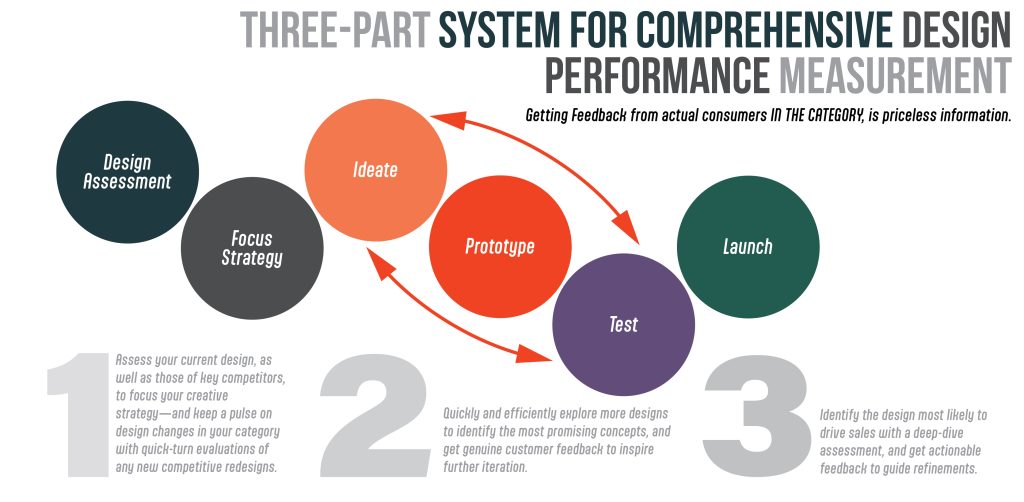CPG brands understand that their package design is almost always the best and last chance to sell their product. It’s proven that design is an incredible growth driver. Moreover, companies are realizing that with products being equal, the main differentiation is brand. The best touchpoint to showcase brand differentiation, is package design.

A Packaging Re-design is Worth the Investment
Syndicated research throughout the process, is an efficient and cost-effective way to provide invaluable design direction. If you understand the expectations of customers, you can apply those insights in design development.
We can start by assessing your current design. The hardest working packages will follow a natural reading sequence.
The Shopper:
- Notices the Package
- Asks, “What is it?”
- Wonders, “Why should I care?”
- Wants to be persuaded
- Needs proof.*
Designing a Successful Package
What if your customers could tell you exactly what they’re looking for in a design? That’s the idea behind syndicated design research. Thorough and insightful analytics reveal where more successful designs hit. Therefore, we know that the best designs stick to these 8 principles in their process.±
Eight Principles of a Winning Package Design Process
- Crafting a clear, strategic, creative brief. Successful designs happen when clear goals are set before the redesign embarks.
- Recognize when a redesign should be evolutionary, not revolutionary. It is possible to improve on an already established design rather that “start from the drawing board.” It is amazing what subtle tweaks can add to the bottom line.
- Remove unnecessary constraints and explore broadly. Even in evolutionary redesigns, consider allowing the design team to go broad in the creative exploration.
- Collect consumer feedback early and often. Don’t wait until the end. Data can be collected at any stage of the process. The more you know, the clearer the design elements come into focus. Testing more than one variation against the current design can sharpen the direction to the final product.
- Prioritize communicating important things better. Communicating attributes that are most important to category buyers has a direct correlation to sales performance. This is determined by asking consumers, not brand stakeholders.
- Adopt bolder, more consistent representations of your design elements. Boosting brand awareness can be achieved by creating a stronger, more cohesive design system that can be applied across product variants consistently.
- Punch up imagery related to sensory appeal, where applicable. Leverage any indication of flavor, scent or sensory indulgence, if applicable
- Avoid chasing trends without strategic rationale. Make well-reasoned design decisions that challenge the category, not the consumer. Understand the difference between trend and “fad.” Look to the fashion industry for insight to presage trends in design for the next 5 or 6 years.
Following this process, will lead to inspired designs, clarity for your consumers, and increased sales in your category.

Now, Let’s See How this Awesome Re-design Works.
Throughout the design process we’ve received feedback from those who matter most (the customers). We’re convinced that our new design will work far better than our current design. How do we validate the new design? Quantitative analysis? Focus Group? Both are somewhat, unreliable ways of testing. Quantitative studies bury problems in mounds of useless data. Focus groups, initially designed to focus research, instead have BECOME the research, which only leads to more questions. That being said, a brand is a gut feeling. We believe that it’s better to test in the product’s space, with quick, easy and instinctual questions.
“
Better a rough answer to the right question,
than a detailed answer to the wrong question.
-Marty Neumeier author, The Brand Gap
”
Should you come to find that your audience can’t understand and communicate your concept, then the design is not working. Analysis while creating is always part of the Bachman process. It’s a proven platform that gets quick, insightful answers at any stage of development. We obtain data comparing current designs to new concepts, or your current design against the competition. Furthermore, we can even project how a new design will increase or decrease sales. We’ll learn together what’s most important to your customer, through their eyes and with real correlative results that can predict the effect on your bottom line.
We’re Here to Help
If you’re considering a redesign, we’re your team! We’d like to provide you with a FREE ANALYSIS OF YOUR CURRENT PACKAGE or show you how changes can grow your sales. Contact us.

